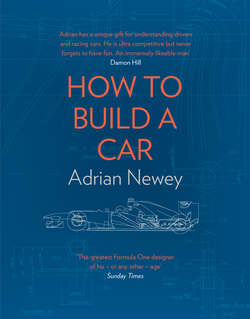Читать книгу How to Build a Car: The Autobiography of the World’s Greatest Formula 1 Designer - Adrian Newey, Adrian Newey - Страница 11
Turn One
HOW TO BUILD A MARCH 83G
CHAPTER 9
ОглавлениеIn 1981, the skirts that Lotus had introduced for their ground-effect car were lifted. New FIA regulations insisted they be at least 6cm off the ground, and could no longer slide up and down, which of course would hugely reduce their effectiveness since they’d no longer be sealed to the track.
In response, teams fitted rubber skirts to the cars, but they didn’t work nearly as well because they flexed in a poorly controlled way and wore out – which is something that rubber does when it slides along the ground.
Those 1981 cars were really 1980 cars with these much less effective skirts. It was my first taste of a major regulation change, and I felt the aero needed to be fundamentally redesigned to re-optimise to this new limitation.
My idea was simple: to raise the underwing and make it longer, so that the leakage under the rubber skirts would be, as a percentage of the overall flow under the car, smaller. It was a sound principle, but to accommodate it meant significantly redesigning the rear suspension.
Straightaway, I was into something I find fascinating: the integration of mechanical and aerodynamic design (something I had tried to bear in mind with my project at Southampton).
We started to develop it through 1981 with the intention of it being the car for 1982. Once a month we’d load a Vauxhall Chevette van with the model and any other tools we needed, and then Pip, our fabricator, and I would drive to the wind tunnel at Imperial College in Kensington.
They were early morning starts, the whole operation conducted in a hurry. On one particularly icy morning I span the Chevette across the slip road onto the M4, clouting the barrier on the outside. Together, we pulled the wheel arch back out to stop it rubbing on the wheel, clambered shivering back inside and kept on going.
Once at the tunnel, we’d do a run on the model, measure how much downforce and drag it produced, and then make alterations to it – for example, by changing the front wing altogether, varying the angle of the existing wing, or doing the same to the sidepods or the diffuser.
Nowadays, there’s almost no adlibbing on the model; everything on it is a pre-manufactured part and test schedules are followed because that’s the best way to be efficient. Back then, though, we’d come armed with all sorts of bits and pieces, with Pip and the model-maker on hand to make alterations, and me recording the results and making calls on what to do next. We had limited resources and there was a lot of improvisation, but if we had an interesting direction we’d make a part on the spot, stick it on and try it.
Our numbers were good, a big improvement on the 1981 car. Bearing in mind we had no idea what other teams were getting from their own cars – you rarely do, of course – we were quietly confident that we had a decent design on our hands. Joining Williams years later, I compared notes with Patrick Head, and based on what he told me about the 1982 Williams car, ours would have been very competitive.
But it’s by no means an easy feat to translate wind tunnel results to the finished article. You need sufficient resources for engineering, detailed design and manufacturing, and in that respect Williams always had a head start. But on paper at least, our Fittipaldi was championship material. We could have been a contender.
The ifs and buts of motor racing. In the event, the rug was pulled …
I’d started at Fittipaldi in August 1980, but by Christmas 1981 it became apparent that there was something rotten in the state of Reading. When I first began, the team was sponsored by Skol beer, and there was, if you will excuse the pun, a fair bit of money swilling about for development and a can-do atmosphere. At the end of that year Skol pulled out, to be replaced by Avis for 1981, meaning much less finance available.
Work continued on the 1982 car. We’d begun designing a rear suspension to complement the aerodynamics – to the point that drawings were ready to go off for manufacturing the components – when suddenly the whole thing was stopped because there was no money left to build the car. We were told we would have to use the 1981 car in 1982.
Staff began leaving. Harvey joined Ferrari. One of the team managers, Peter Warr, left for Lotus and the other, Peter Mackintosh, joined March. That positive, can-do attitude evaporated.
It was with a heavy heart that I found myself looking for something new.
